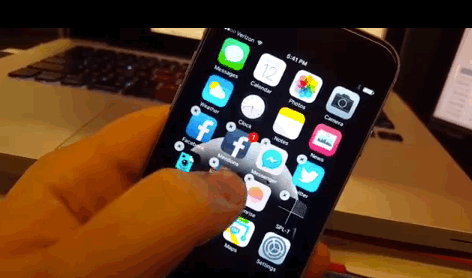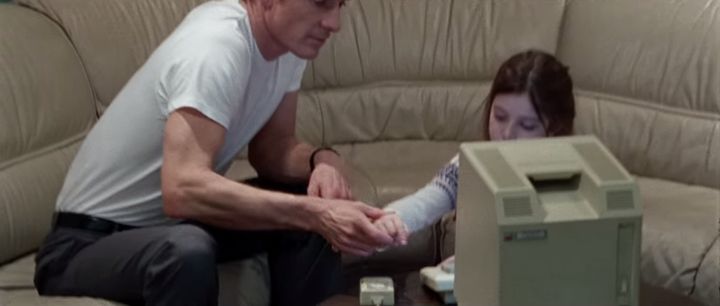If you're spending cash to see "Steve Jobs," Hollywood's new movie on Apple's great innovator, it's probably because you want to see the big-screen, high-definition take on his boxy black NeXT Computer System. "That ebony plastic!" you'll gasp as Michael Fassbender talks about the slight asymmetry of its chassis and its chances of widespread adoption in university library systems. "This... this is best picture material," you'll whisper to your date, who's trying to keep it together and not drool too much.
Or, wait: You probably want to know about what started Jobs on the path to the iPhone, arguably the most meaningful piece of consumer technology in our modern era. But you never actually see an iPhone or hear the word "iPhone." The film makes an interesting gambit, focusing on the original Macintosh computer, that NeXT unit you've probably never heard of and 1998's round, blue iMac. That's it.
But make no mistake: iPhone is the ghost haunting this movie. Allusions to the handheld device are everywhere. (Some spoilers for the film follow.)
Quartz's Mike Murphy pointed one of them out -- Jobs gazes toward a bright table that reflects a familiar glow in his glasses:

There's more. Steve Jobs kneels over a precise grid of papers in an early shot, carefully re-positioning them around the floor by dragging them around with his fingers -- an action reminiscent of moving square apps around on your iPhone's screen:


In another sequence, an audience is positioned underneath app-shaped panes of glass:

Steve Jobs himself is similarly reflected in those squares of glass when he appears onstage:

There are other instances, though images of these moments aren't readily available online. For example, Jobs' young daughter tries to interact with an early Macintosh by poking "buttons" on the screen. At another point in the movie, Apple introduces the Newton, a too-soon PalmPilot precursor that fell on its face.
You could call all of this imagery "coincidence," a word Jobs viciously deploys during an emotional scene. The director, cinematographer and art director who might spend hours to choreograph and capture a handful of seconds on film would probably disagree.
While the iPhone is literally absent from the film, its presence is nonetheless felt. Jobs' mission in the movie -- which takes some liberties with its nonfiction source material -- is to eliminate the membranes separating humans from their machines. When he's preparing to introduce the Macintosh, he makes a big stink about the revolutionary one-button mouse, which allows his very young daughter Lisa to easily interface with the computer and draw in MacPaint. The NeXT is supposed to be a tool that reduces the friction in academic research. iMac is introduced as the Internet is entering mainstream awareness, and it's meant to be the most approachable computer of all time.
For the entire film, Jobs, the character, is hurtling toward computers that rest in our hands and connect us to people and information at a moment's notice. The tragic irony is that Jobs is emotionally incapable of connecting with his daughter, from whom he purposefully distances himself. This visionary who dreamed of gadgets that connect with people is... unable to connect with people himself.
It's certainly a concept that's been explored before. But "Steve Jobs" takes it to an interesting new place at the very end of the movie.
(🚨Seriously, spoilers ahead.🚨)

In a final do-or-die moment with his now 19-year-old daughter, Jobs makes the ultimate statement of devotion by presenting her with a paper printout of the drawing she made on MacPaint so many years before. It's a little bit of a schmaltz-fest, but it asks for an interesting bit of interpretation from a viewer who's familiar with Jobs as the idea-generator -- if not the architect -- behind the iPhone.
Writer Aaron Sorkin could have scripted "Steve Jobs" to end with an emotional encounter between Jobs and his daughter Lisa at the 2007 iPhone unveiling. Why not? It's basically fiction, anyway. Jobs might've pulled up Lisa's MacPaint drawing on his brand new smartphone -- maybe it could have been his wallpaper! -- and said something like, "You're always with me, Lisa." There would have been tears.
Instead, he had a folded piece of paper.
You could probably take this in one of two ways. Perhaps it's a critique of smartphones and their ability -- or inability -- to connect us in emotionally significant ways. Jobs has to actually come face-to-face with Lisa and talk to her at the end of the movie. He hands her a physical object.
Or, perhaps we're meant to read this as yet another allusion to the iPhone. The handheld paper is powerful -- consider the possibilities that the handheld computer affords us.
Given the somewhat cynical perspective aired by Sorkin's previous look at Silicon Valley, "The Social Network," I'm inclined to go with the former theory. But see it and decide for yourself when it opens wide Oct. 23.
